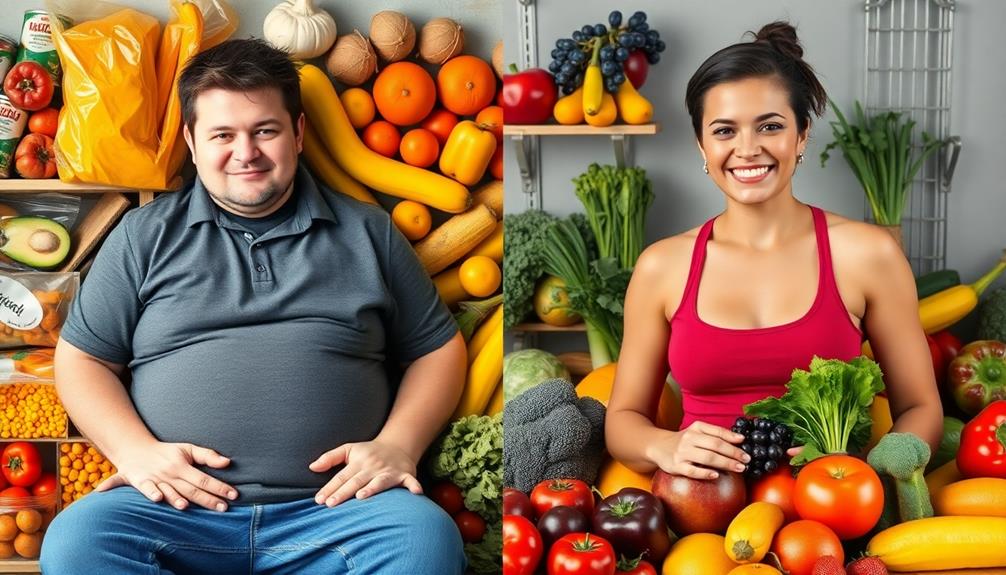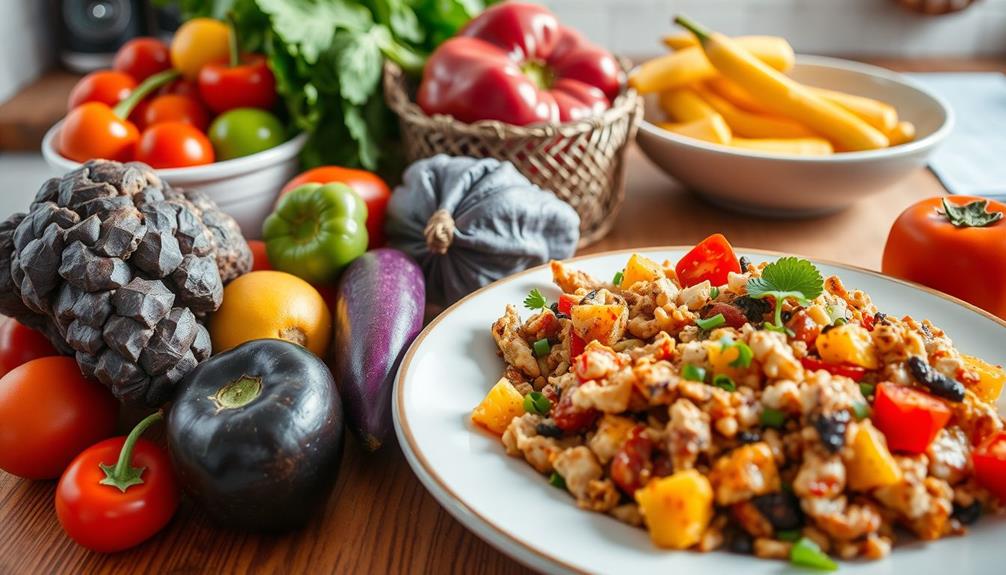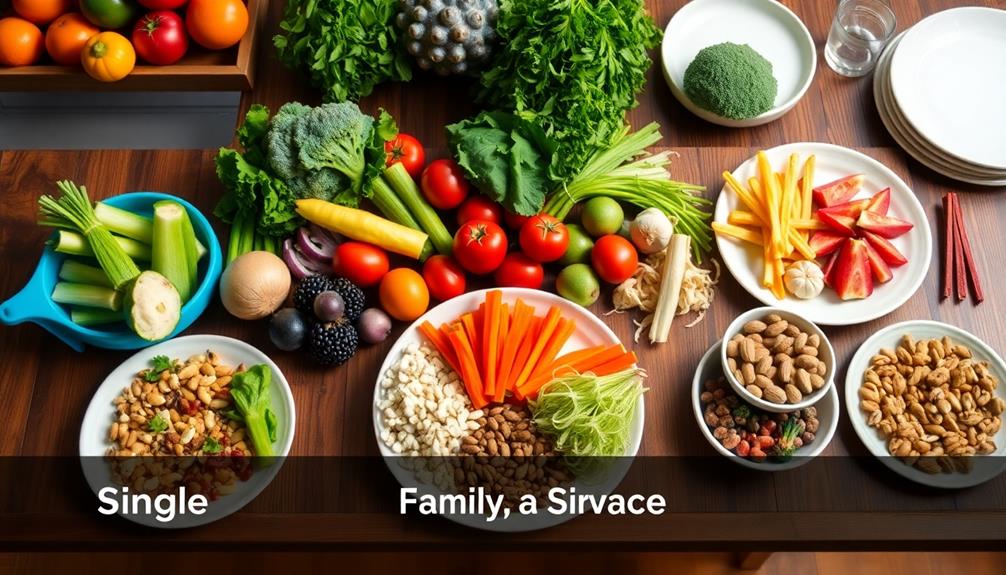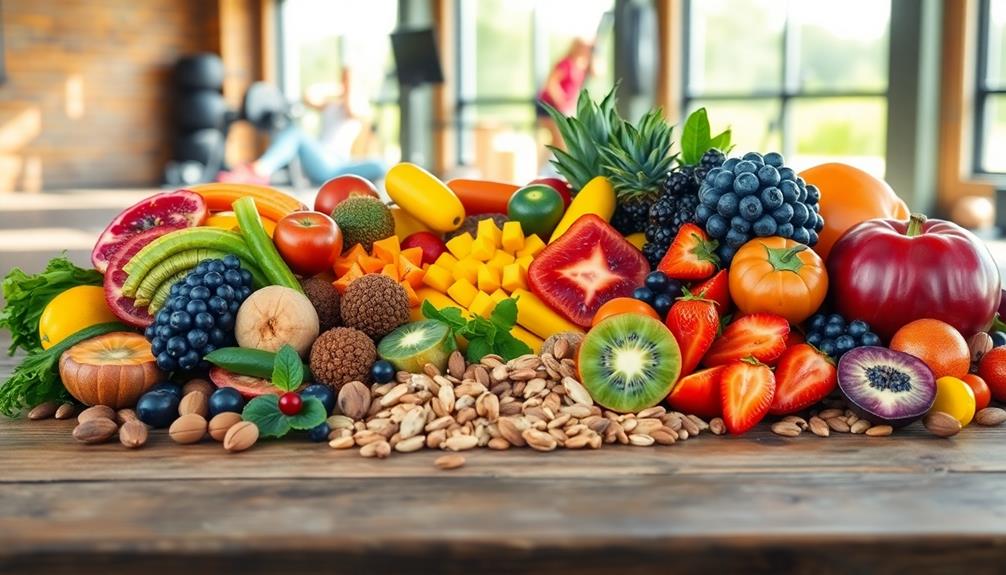You'll be amazed by the success stories from those who've embraced the raw food diet. Many report significant weight loss—some shedding up to 66 pounds—while experiencing heightened energy and improved digestion. Participants often find emotional resilience, gaining better mood stability and mental clarity. Transformations include clearer skin and revitalized health, which leads to more enjoyable daily activities. Incorporating nutritious options like fruits, greens, and sprouted foods is key. You'll want to contemplate strategies like "Raw till four" to enhance nutrient balance. Discovering how these changes impact lives can be genuinely inspiring as you explore further!
Key Takeaways
- Many individuals report significant weight loss, with some losing up to 66 pounds within the first few months of a raw food diet.
- Participants often experience improved energy levels and mental clarity, enhancing their overall quality of life.
- Emotional resilience increases, with many finding renewed self-awareness and mood stability after transitioning to a raw food diet.
- Supportive social circles and meal planning strategies, like "Raw till four," contribute to sustainable dietary changes and enjoyment.
- Health improvements include clearer skin, better digestion, and reduced migraines, reflecting overall wellness transformations.
Overview of Raw Food Diet
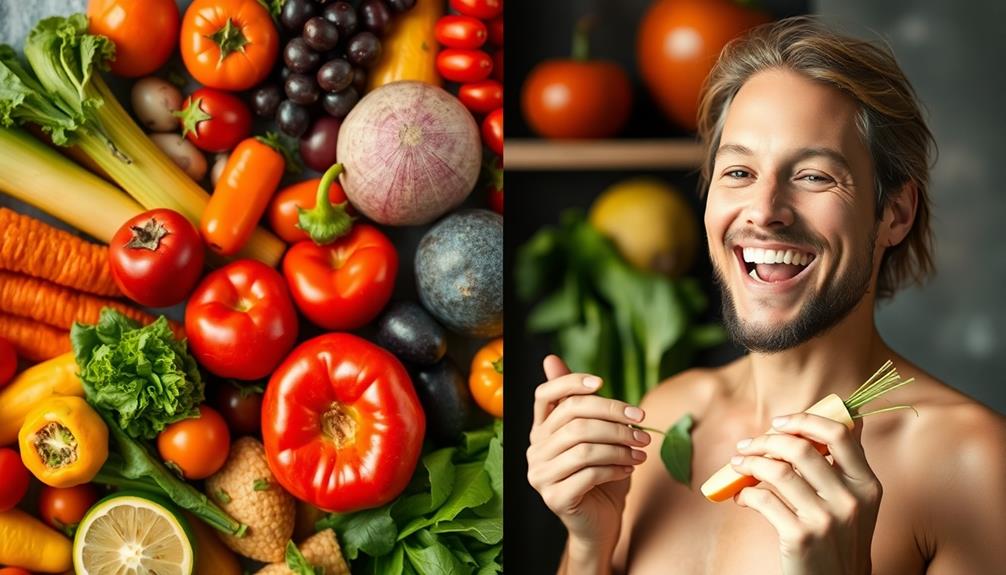
The raw food diet focuses on eating unprocessed, whole foods like fruits, vegetables, nuts, and seeds. By committing to a 28-day trial, you can observe significant physical and emotional changes. Many participants report increased energy levels and improved digestion during their journey with raw foods, which is supported by the benefits of raw food such as enhanced skin health and potential weight loss.
You might find daily meal plans quite invigorating, typically including green smoothies for breakfast, mixed salads for lunch, and a variety of raw dishes for dinner. This variety promotes a well-rounded intake of nutrients.
As you shift to this lifestyle, expect some emotional fluctuations. Initially, you might feel irritable, but as your body adjusts, you could experience heightened awareness and mental clarity.
The raw food diet encourages you to explore nutrient-dense options like sprouted grains and superfoods, which can enhance your meals. However, it's essential to monitor your sugar and fat intake to maintain balance and prevent any nutritional pitfalls.
Personal Transformation Stories

You might be surprised by how a raw food diet can transform not just your body, but your entire outlook on life.
As you commence this journey, you'll likely build emotional resilience and discover newfound strength in facing challenges.
Let's explore the powerful stories of those who've embraced this lifestyle and found their path to health and fulfillment.
Journey to Health
Beginning a raw food diet often transforms lives in ways people never imagined. For many, this journey to health is fueled by a desire to overcome burnout and reclaim vitality.
Shifting to raw vegan food can lead to dramatic changes, including significant weight loss—66 pounds for some, with 44 pounds gone in just the first four months.
Here are three key aspects that facilitate success on this path:
- Meal Planning: Utilizing strategies like "Raw till four" helps maintain high fruit consumption and guarantees a balanced intake of nutrients.
- Holistic Benefits: Participants often experience enhanced mental clarity, increased energy levels, and improved skin health, proving that the benefits extend beyond just weight loss.
- Support and Coaching: Ongoing support after the initial dietary change is essential. It fosters sustainable lifestyle modifications and helps avoid reverting to unhealthy habits.
As you start on your own journey to health, remember that each choice you make contributes to your overall well-being.
Embrace the transformative power of raw vegan food, and watch as your life evolves in remarkable ways.
Emotional Resilience Building
Emotional resilience often flourishes on the journey to a raw food diet, as many individuals discover renewed self-awareness and mood stability within just a week. You might find that eliminating processed foods leads to heightened mental clarity and reduced irritability, fostering a positive emotional state.
| Challenge Faced | Positive Shift |
|---|---|
| Cravings and emotional triggers | Healthier coping mechanisms |
| Mood fluctuations | Stabilized emotional state |
| Isolation in dietary changes | Sense of community support |
As you confront cravings, you'll develop healthier ways to cope with stress and emotional triggers related to eating. Documenting your emotional experiences alongside dietary changes can reveal patterns that link your food choices with your emotional states. This insight builds emotional resilience and helps you recognize how good energy from whole foods influences your well-being.
Engaging with others on a similar journey enhances your experience, as shared stories create a sense of collective understanding. With each step, you'll not only transform your diet but also fortify your emotional resilience, making it easier to embrace life's challenges with renewed strength and positivity.
Daily Meal Plans
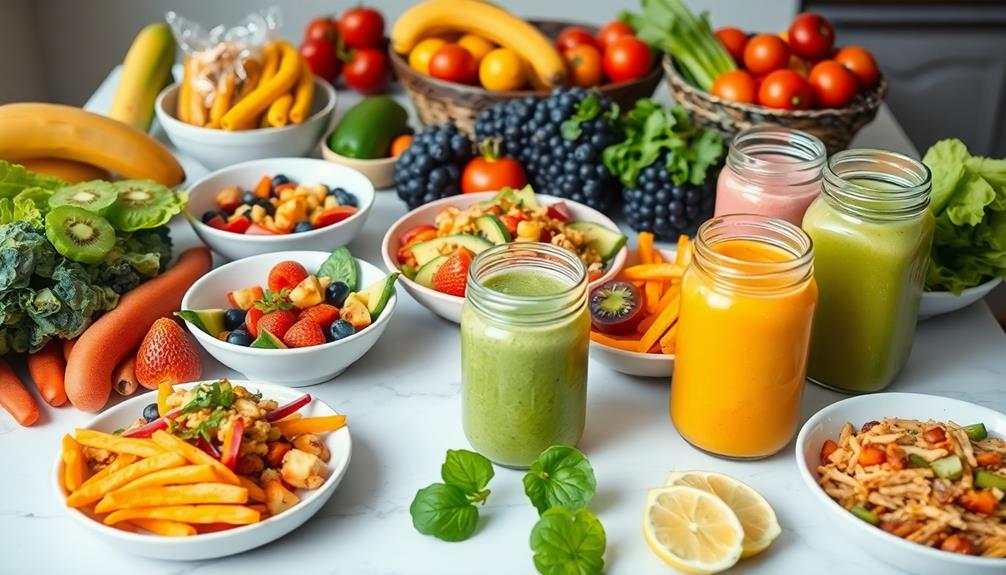
Crafting a daily meal plan for a raw food diet can be both exciting and rewarding. It allows you to explore a variety of flavors while ensuring balanced nutrient intake. Here's a simple daily plan to get you started:
- Breakfast: Enjoy a smoothie bowl made with bananas, pineapples, and a sprinkle of raw cacao. This high-fruit meal keeps your energy levels up and satisfies your sweet tooth.
- Lunch: Prepare a vibrant salad with mixed greens, avocado, cherry tomatoes, and a homemade dressing using miso paste. This combination provides healthy fats and essential vitamins.
- Dinner: Create a hearty raw vegetable stir-fry using sprouted foods and an assortment of colorful veggies. Pair it with nuts or seeds for added protein.
Don't forget to include snacks between meals! Nuts, seeds, and dried fruits are excellent choices to keep your energy up throughout the day.
Engaging in food prep can make the shift to eating raw smoother and more enjoyable. By embracing variety and creativity, you'll discover a wide range of satisfying meals that nourish your body.
Emotional and Physical Effects
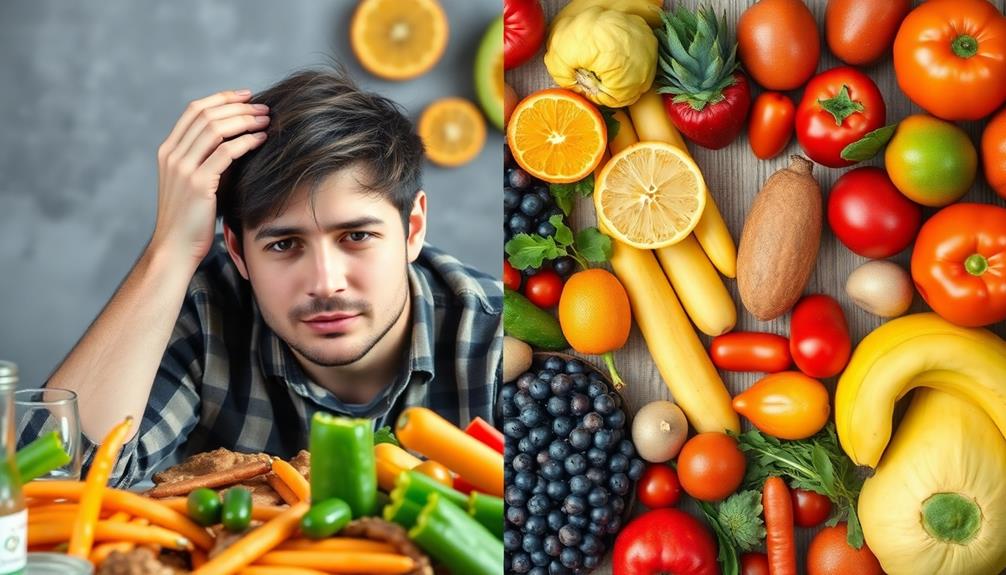
As you embrace a raw food diet, you might notice a boost in your emotional resilience alongside enhanced physical well-being.
Many people report feeling more in tune with their emotions and experiencing increased energy levels. This heightened awareness can lead to improved decision-making regarding food choices, as individuals become more conscious of their nutritional needs and potential deficiencies, such as potential nutrient deficiencies that may arise from unbalanced diets.
These changes often lead to a greater awareness of how food choices affect both your mood and your overall health.
Emotional Resilience Improvement
Shifting to a raw food diet often sparks a remarkable change in emotional resilience. As you embrace nutrient-dense foods, you may notice a surge in energy levels and improved mental clarity.
Many individuals report considerable emotional resilience improvements, though it's common to experience fluctuations during the early days. You might feel irritable or exhausted, especially around Day 4, highlighting the deep connection between your diet and emotional state.
Here are three key benefits you can expect:
- Improved Mood: Participants frequently report reduced anxiety and fewer migraines, leading to a more stable emotional state.
- Better Sleep Quality: You may find that your sleep improves, contributing to your overall sense of well-being.
- Enhanced Awareness: As you become more mindful of your emotional responses to food, you'll be better equipped to manage cravings and develop healthier coping mechanisms.
Ultimately, shifting to a raw food diet can greatly enhance your emotional resilience, allowing you to navigate life's challenges with greater ease and stability.
Embracing this lifestyle not only nourishes your body but also cultivates a more robust emotional foundation.
Enhanced Physical Well-being
Shifting to a raw food diet can greatly enhance your physical well-being, often leading to a revitalized sense of energy and vigor. Many who embrace this lifestyle report significant boosts in energy levels and mental clarity. You might find yourself experiencing a natural high, with mood stability that lasts throughout the day.
As you consume more raw foods, you could notice a reduction in migraines and digestive issues, contributing to better overall health and improved sleep quality. With this heightened awareness, you'll likely recognize how your food choices impact your emotional state, allowing for better management of irritability and cravings.
Your skin health may improve, too, as clearer complexions and healthier hair often accompany a nutrient-dense diet. Additionally, you might feel more motivated to engage in physical activities, finding that shorter, intense workouts become easier and more effective. Improved recovery times and energy levels can make all the difference.
In essence, a raw food diet not only fuels your body but also enhances your emotional connection to food, leading to a more vibrant and fulfilling life. Embrace this journey, and enjoy the myriad benefits it brings!
Nutritional Insights and Tips
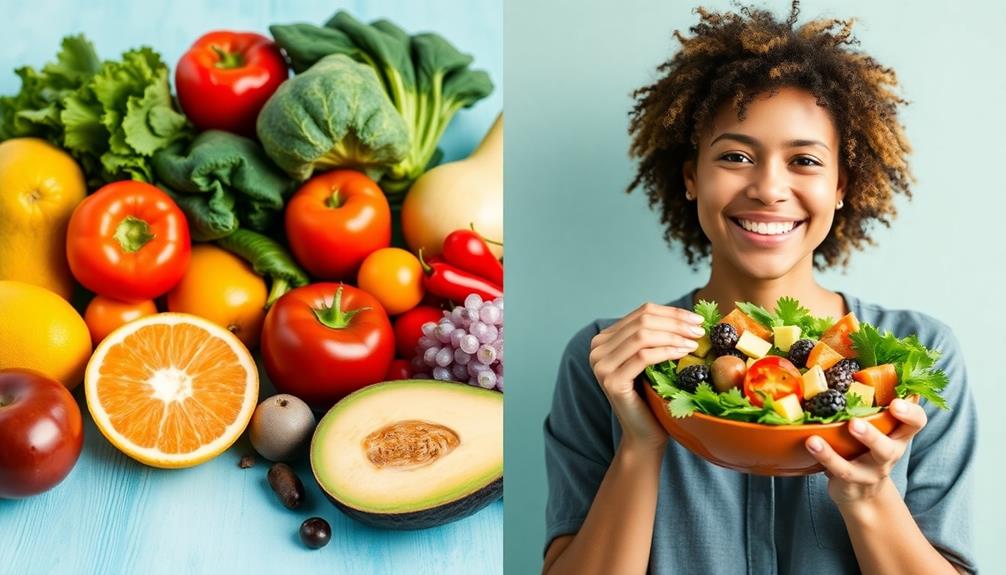
When starting on a raw food diet, understanding the nutritional landscape is vital for success. Emphasizing whole, unprocessed foods can lead to significant health improvements. Here are some nutritional insights to guide your raw eating journey:
- Diversify Your Diet: Incorporate a variety of fruits, greens, and sprouted foods to guarantee a balanced nutrient intake. This helps prevent monotony and assures you're getting adequate vitamins and minerals.
- Focus on Caloric Density: Regularly consume high-calorie fruits like bananas and pineapples to stave off constant hunger. This strategy will keep your energy levels stable and your cravings in check.
- Supplement Wisely: If you're on a raw vegan diet, consider B12 supplementation, as this essential nutrient is primarily found in animal products. Monitoring your nutrient intake is critical for overall well-being.
Meal planning, like following a "Raw till four" approach, can effectively support your weight loss goals while assuring you prioritize nutrient-rich greens.
Energy and Mental Clarity

As you embrace a raw food diet, you might notice a remarkable boost in your energy levels and mental clarity. Many individuals report feeling euphoric and vibrant throughout the day, a stark contrast to the sluggishness that often accompanies processed foods.
Initially, you may experience fluctuations in focus; however, as your body adjusts to raw foods, the mental fogginess tends to lift.
You'll likely find that your cognitive function improves, allowing you to think more clearly and effectively. Participants often mention a reduction in cravings for stimulants like caffeine, which can further enhance your mental clarity.
While the change may bring emotional ups and downs—irritability and exhaustion can be common at first—these feelings usually stabilize over time.
Ultimately, the raw food diet can lead to a more balanced emotional state and consistent energy levels, positively impacting your daily activities.
With enhanced energy and clearer thinking, you'll likely feel more equipped to tackle challenges and pursue your goals. Embracing this lifestyle can transform not just your physical health but also your mental well-being, making every day feel more vibrant and fulfilling.
Social Life Adjustments

Steering through a raw food diet often requires you to make adjustments in your social life, particularly when it comes to dining out or attending gatherings. You might find yourself managing new dining habits and meal choices to align with your dietary restrictions.
Incorporating herbal teas can complement your raw food lifestyle, providing various health benefits without compromising your dietary choices. For instance, enjoying a cup of herbal tea can promote relaxation and digestion, enhancing your overall well-being.
Here are three strategies to help you maintain your social connections while adhering to your raw lifestyle:
- Communicate Openly: Share your dietary choices with friends and family. Open discussions can foster understanding, making social interactions smoother.
- Seek Supportive Friends: Surround yourself with people who encourage your raw food journey. Supportive friends can make a significant difference, reducing feelings of isolation during social events.
- Plan Ahead: When attending gatherings, coordinate with the host about meal options. Bringing a raw dish to share can guarantee you have something to enjoy while also introducing others to your diet.
Finding this balance between your social life and raw food preferences is essential. It allows you to enjoy interactions without compromising your health goals, making your raw food journey more fulfilling and connected.
Challenges and Obstacles
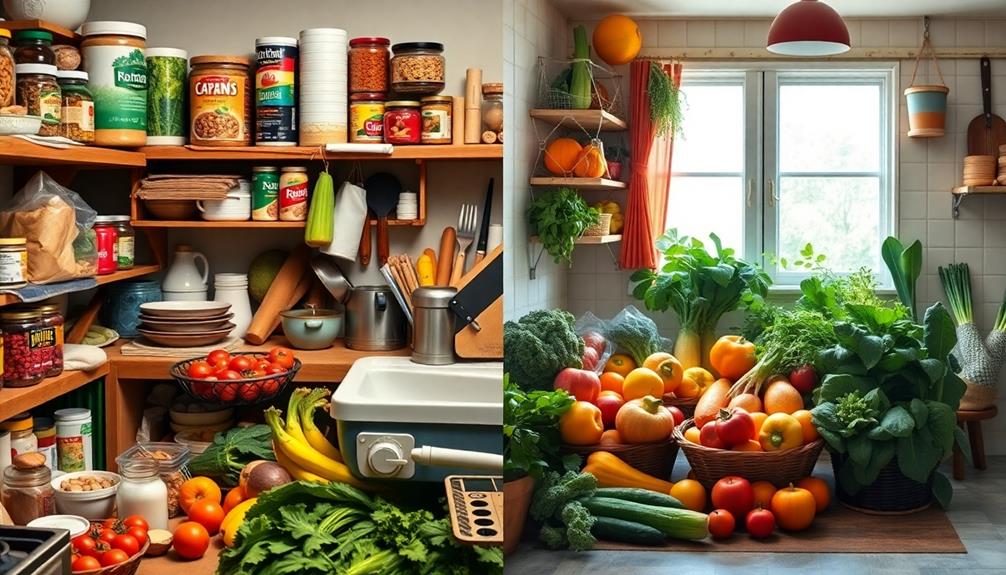
Maintaining a raw food diet can come with its fair share of challenges and obstacles. As you shift, you might experience cravings for non-raw foods, which can complicate your hunger and fullness cues. Emotional responses are another hurdle; irritability and exhaustion often accompany initial dietary changes, making this period particularly tough.
You may also face social implications, feeling isolated if friends and family don't understand your choices. Physical discomfort, like nausea and digestive issues, can arise during detox, adding to your stress. Finally, financial considerations can strain your budget, as raw food supplies and specific ingredients often come with higher costs.
Here's a table summarizing some of these key challenges:
| Challenge | Description | Emotional Responses |
|---|---|---|
| Cravings | Yearning for non-raw foods | Frustration and irritability |
| Social Isolation | Feeling unsupported by friends and family | Loneliness and disconnection |
| Physical Discomfort | Nausea and digestive issues during detox | Exhaustion and mood swings |
Navigating these obstacles requires persistence, but understanding them can help you prepare for the journey ahead.
Health Improvements Observed

Transforming your diet can lead to remarkable health improvements that many raw food dieters enthusiastically report. You might experience a range of benefits that enhance your overall well-being. Here are some notable health improvements you could observe:
- Weight Loss: Many individuals have lost significant weight, with some shedding up to 66 pounds, particularly in the initial months of their raw food shift.
- Enhanced Energy Levels: You'll likely notice a boost in your energy levels, making daily activities feel less exhausting and more enjoyable.
- Improved Digestive Health: Switching to a raw diet often alleviates digestive issues, reducing symptoms like nausea and migraines, resulting in greater comfort.
In addition, participants often report enhanced mental clarity and improved mood stability, contributing to a more positive daily experience.
Your skin health may also improve, leading to a clearer complexion that reflects your internal wellness.
Moreover, the increased consumption of nutrient-dense foods positively impacts menstrual health and overall physical well-being.
Embracing a raw food lifestyle can truly transform your health and well-being in profound ways.
Future Dietary Considerations
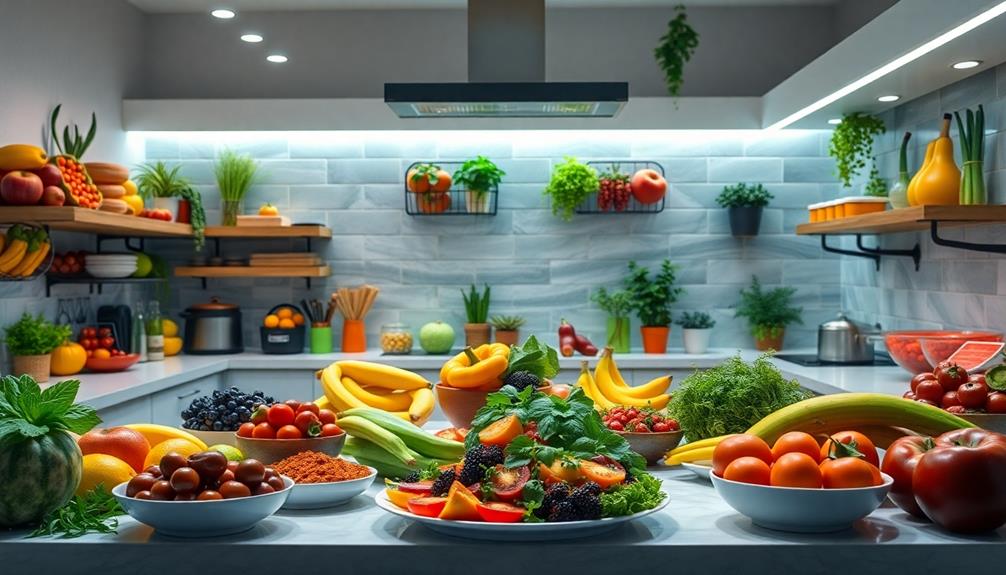
As you continue your journey with a raw food diet, it's crucial to reflect on long-term dietary adjustments to meet your evolving nutritional needs.
You might find that incorporating supplements, especially B12, becomes necessary to maintain your health.
Customizing your meal plans to include a variety of nutrient-dense foods will help you sustain energy and avoid deficiencies.
Long-Term Dietary Adjustments
Many people find that long-term dietary adjustments are vital for sustaining a raw food lifestyle. To maintain a balanced mix of nutrients and satisfy cravings for warmth, consider these strategies:
- Incorporate Cooked Foods: Mixing raw with cooked meals can enhance nutrient density. A "Raw till four" approach allows you to enjoy high fruit intake during the day while savoring cooked meals at night.
- Listen to Your Body: Regularly assess your hunger cues and calorie intake, especially from calorie-rich fruits like bananas and pineapples. This practice helps you avoid constant hunger and guarantees your energy levels remain stable.
- Explore Personal Preferences: Continually experiment with your dietary preferences, including the use of herbs for stress relief. This can enhance your overall well-being and help prevent a return to unhealthy eating habits.
Nutritional Supplementation Needs
Guiding a raw vegan diet often means you'll need to step up your game with nutritional supplementation to guarantee you're meeting all your dietary needs. One of your primary nutritional supplementation needs is vitamin B12, as this essential nutrient is mostly found in animal products. It's important for nerve function and red blood cell formation, so don't overlook it.
Incorporating nutrient-dense superfoods like spirulina and chlorella can help you meet your protein and micronutrient requirements. Additionally, consider using adaptogenic herbs such as ashwagandha to support adrenal health and relieve stress, which is particularly important when making dietary changes.
Regularly monitoring your intake of calcium, iron, and omega-3 fatty acids is necessary for balanced nutrition on a raw vegan diet. If you're unsure about how to achieve these levels, consulting with a healthcare professional is a good idea.
Investing in high-quality supplements might cost around €700 annually, but it can greatly enhance your overall health outcomes and support your long-term success on this diet. So, take the time to prioritize your nutritional supplementation needs for the best well-being.
Frequently Asked Questions
How Fast Can You Lose Weight on a Raw Food Diet?
You can lose weight quickly on a raw food diet, often averaging 1-2 pounds per week. Some individuals report even faster results, especially during the initial detox phase when your body adjusts to new eating patterns.
How Successful Is the Raw Food Diet?
You'll feel like a superhero on the raw food diet! It's incredibly successful for many, boosting energy and clarity. With vibrant fruits and veggies, you'll conquer cravings and transform your health in remarkable ways!
Are There Any Famous People on a Raw Food Diet?
Yes, many famous people follow a raw food diet. Celebrities like Alicia Silverstone, Woody Harrelson, and Jared Leto advocate for its health benefits, while Gisele Bündchen attributes her glowing skin to this lifestyle choice.
Can You Survive on a Raw Diet?
Yes, you can survive on a raw diet, but it requires careful planning. You'll need to guarantee you're getting all essential nutrients, as it can be challenging without proper food variety and supplementation.
Conclusion
In exploring raw food diet success stories, it's evident that many people experience remarkable transformations, both physically and emotionally. Did you know that studies show a raw food diet can lead to a 30% reduction in chronic disease risk? As you consider this lifestyle, remember the importance of balance and listening to your body. Embracing raw foods can be a rewarding journey, but it's crucial to stay mindful of your nutritional needs and challenges along the way.

